“What do you think, Fawnie?” I turn to the head of the herd, slowing my pace to let her take up the lead, “Which way today?”. Fawn the Goat stands still on the ridge beside me and the herd come to a halt behind her and stand, flicking their tails and stamping at flies, looking at me, looking at Fawnie, expectantly, waiting. Fawnie lifts her nose to the wind. Her nostrils widen, inhaling the currents, drawing the scents of the weather and landscape across her olfactory sensors. She takes her time, scans the horizon, looks this way for a moment and then that way as though considering her options. Then abruptly, decision made, she turns away from the cold, east wind and walks purposefully, west, down the hoof-trodden goat path across the heath. The herd follow. I stand back and watch them wind their way down the hill. Fawnie strides ahead, the older does snake in single file behind, the young ones skip playfully over the heather, until they round the outcrop into a sheltered dip below the rocks where Fawnie stops, looks around, takes a bite of something green, and the herd follow suit and settle to browse.
Fawn the Goat is our lead goat, our herd matriarch, our Queen. She’s not the first goat we ever had but she’s the first of our current herd. We don’t breed her anymore, but we keep her around because, well, what would a herd be without their queen? She’s earned her retirement, we tell ourselves to justify the costs of her keep and our sentiment for our beloved old milk goat, but it’s also because Fawnie has an integral, fundamental place in the herd.
Fawnie came to us from the hills out west, a hill farm where she was bred and raised on gorse and heather on rough, exposed, hill land like ours. She’s got heather and shale and Atlantic rain running through her veins. Her blood, built of the iron and rivers of these hills, running through her daughters and granddaughters and great-granddaughters, is most precious to our herd. Fawnie’s grandbabies get first pick for keepers, no question. But it’s her elder-wisdom, learned and inherited, earned through her lifetime and coded in her genes, that is more valuable than any more kids or gallons of milk she may or may not produce.
Fawnie knows the lay of the land. She knows which way the winds blow, where to go for a sheltered spot to find fresh greens when that bitter easterly blows a chill through her bones. She knows where the best things grow, and when; where to find what the herd need to eat throughout the seasons. Sometimes Fawnie lets me lead, for reasons that are hers and hers alone. But if she’s not happy with the direction I choose, or there’s rain coming, she lets me know. Most times if I walk in front I get the same treatment any of the other herd members get if they dare take up the lead: Fawnie charges ahead with a toss of her head to remind me she’s the Queen. And who am I but her humble herder? We work together, she and I, to make sure the herd go out and get what they need. Sometimes, because she doesn’t need to eat as much as the growing young ones or the does in kid, and being the leader entails more important work than feeding, Fawnie brings the herd out to her chosen spot and then stands watching, watching the horizon, keeping an eye on things, while the herd fill their bellies.
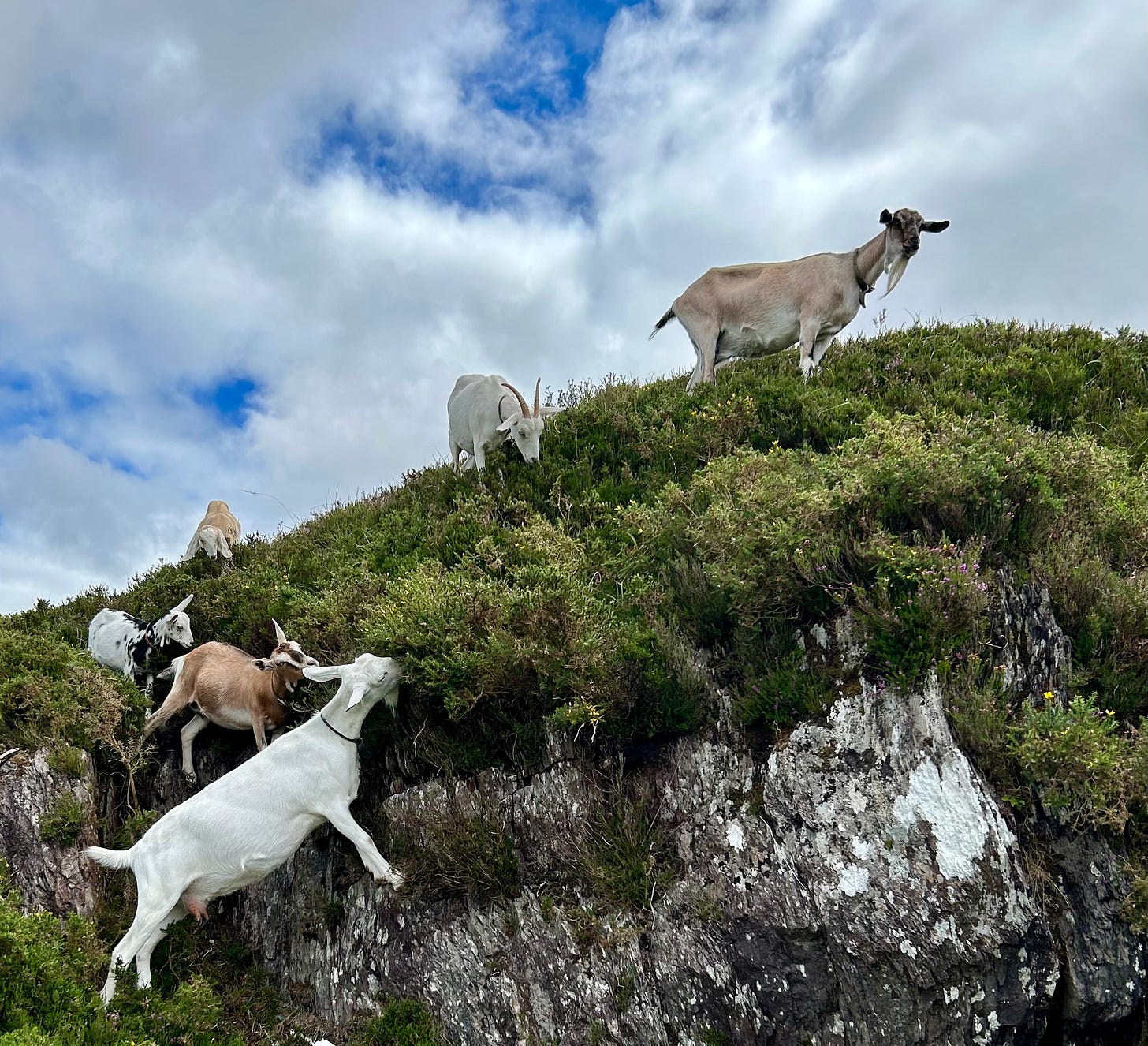
One or two other, younger females in the herd might have what takes to become the leader, if Fawnie were to disappear. Neither are the biggest or strongest of the goats, but that doesn’t matter, it’s not brute strength that makes a leader (although that does help to maintain the position). It’s the wherewithal to think for herself, to work things out, make a decision, and the confidence to act on it, to take the initiative, to step out in front and show the way regardless of whether or not anyone follows. Lead, and they will follow. But, they don’t have Fawnie’s experience, maturity, or knowledge of the land.
In Nourishment, animal behaviourist Fred Provenza, speaking of herd dynamics and how herbivores interact with their landscape to find their nourishment, says:
“A matriarch’s knowledge of biophysical haunts is key to the health of her family. …families led by older, more knowledgeable matriarchs have better reproductive success and survival of their offspring than families led by younger matriarchs. …changes in leadership when older females are culled from the herd can dramatically alter how families use habitat, including food resources…”
And
“The practice of culling livestock that no longer produce offspring has become common… with little thought given to how it might affect the social organisation of livestock herds. The consequences can be severe when herds without matriarchs must fend for themselves… …a matriarch can maintain the health of her family by meeting the needs of different family members through grazing circuits. By knowing when and where to move, she can enable individuals with different needs—young and old, males and females—to eat a broader array of plants and to forage in a greater variety of locations, thus enabling health. Such rotational grazing without fences would help to maintain the biodiversity of landscapes.1”
I have made a few unenthusiastic and not well received attempts to manage my goats’ rotations on the land for the sake of impacting areas I want to impact or saving other areas for late season forage, but Provenza’s research confirms my amateur observations: that when given the space and freedom to come and go and forage as they choose, the herd, aligned to their place and led by their matriarch whose knowledge of her landscape and the needs of her herd will always outshine mine, will naturally rotate over the land, concentrating on one area before moving on to the next according to the season, weather, and growth stage of the plants they eat.
I watch the herd browse, highly selectively, over the hill forage. They ignore swathes of sweet summer grass to delicately pick gorse flowers, select bunches of bog myrtle, or climb down a precarious rock ledge to snatch a choice fern or a wayward bramble leaf. Occasionally they dig under the heather for roots or a mouthful of clay—a mouthful of minerals and microbes—or use their long lower incisors to scrape mosses and lichens off the rocks. The youngest kids start to eat roots, soil and moss off the rocks first, before they begin to nibble at leaves, flowers, buds, shoots, bark, twigs and grasses with the herd.
Our hill land is poor, our soils and pastures are lacking in minerals and diversity, but Fawnie and her daughters and granddaughters do not suffer from the mineral deficiencies or weaknesses that I see in other goats we buy in. Their hooves are hard, their udders are full and their coats shine. They are adapted to their landscape. They know where to find what they need. The only times I’ve seen their health decline (gummy eyes, coughs, lowered fertility—all signs of vitamin deficiencies) is when they’ve been indoors eating hay through extended seasons of wet weather. We give them seaweed and minerals and the best hay we can buy and we cut armfuls of tree forage, ivy and anything green we can find to bring them something fresh every day, but nothing, no amount of supplements or fancy feeds can compare to the robust, resilient health gained by foraging freely for themselves.
Our bucks spent the summer foraging freely on the lower slopes, a safe distance from the female herd, finding their own sustenance and shelter and doing their own bachelor buck thing. They had access to a built shelter and hay but they preferred to stay deep in the wooded creek eating leaves and bark during bad weather. They’re young bucks, they’ve grown out well on the land with no inputs from us and they came up strong and gleaming, lean but fit on the forage, sleek, robust and vital, muscles and hooves hardened by the hill, eyes bright, perky and ready for the ladies. And if they didn’t? If they couldn’t make their own way through a summer of abundant forage on the land their offspring will have to thrive on? Well, then they wouldn’t make the mark for breeding. They’ve done good work down there, clearing the scrub along the creek, finding our boundary line, testing our boundary fences. They may or may not have spent more than a few days exploring the young spruce forestry below. But it’s time to come in now. Time to come in and grow soft on sweet hay and a straw bed. They didn’t want to come in. Why would they? Why come in to eat hay when they’ve got brambles and birch and ivy and willow and oak? They turned their noses and chewed their cud until we brought them to the ladies and they forgot about food.
A farmer we know has a prized cow who had a little calf not so long ago. But he didn’t have the grass on his fields to feed her, such a poor year it’s been to have a calf born so late, and that poor cow was struggling. A fierce mother, but she didn’t have the milk to feed her calf and her own weight was dropping off her fast with what little she had going to her calf. Our friend teetered on the difficult decision to sell the cow and calf, to take the chance that someone else might have the grass to feed her. But she’s a prized cow, not one to be parted with so easily, so in a list ditch effort to get her fed and milky, he turned her out onto the hill, to let her take her own chances at finding what she needs among the frost-sweetened gorse and heather. I don’t know how that cow and her little calf are faring out on the hill, time will tell, but I’ll wager he made the right decision. We’ve seen it well enough in our goats, when all the feeds and supplements just aren’t cutting it, turn them away to find their own sustenance and they do, and they come back hale and hearty, grown out and gleaming.
We’ve bought in goats from herds bred in barns and flat, boring fields of weedless pasture. When we let them out onto the hill they didn’t know what to do. They didn’t know how to climb the rocks and they didn’t know what to eat. They watched and copied Fawnie and her herd, and tentatively began to pick at the heather. It tasted pretty good, so they ate some more. They learned to navigate our rugged ground and figured out what to eat by following and copying the herd. At first they struggled to keep up. But slowly, their hooves and muscles hardened, their bellies adapted to the rough forage and their senses tuned to the landscape. They learned to find what they need. They are fit and glowing. But still none of them have Fawnie’s wits. They wouldn’t cope on their own. That takes generations of adaptation, of hefting to the land, and the strong instincts and intelligence that have been bred out in favour of productivity and docility. Fawnie is not an easy goat to handle. She’s strong, she’s got a mind of her own and she makes sure I know it. She’s a leader, not a follower. But I want animals that thrive and flourish in their landscape, as part of their landscape, who give milk churned from heather, gorse and rain. Milk made from the land, not milk made from soy by mollycoddled milk machines kept indoors with every grain of their diet and routine managed, but by goats who climb the rocky peaks to soak in the sunrise and scrape minerals from the lichen. And for that they need the leadership of a matriarch who knows the land and what grows when and where, what’s good to eat and what isn’t, whose bones are built from the very rocks she stands on.
Provenza, F. (2018). Nourishment: What Animals Can Teach Us about Rediscovering Our Nutritional Wisdom. Chelsea Green Publishing. pp.182-183.



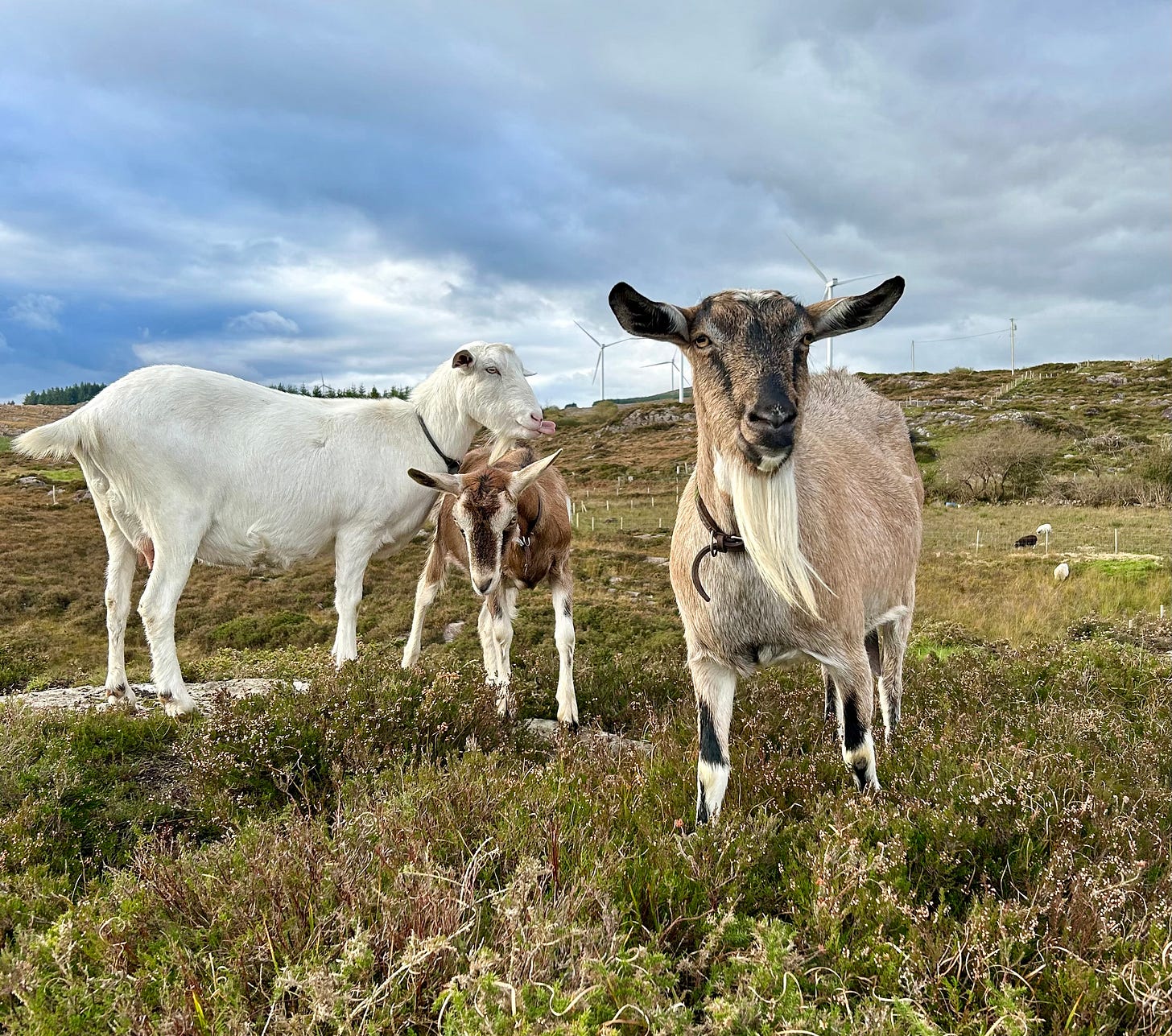
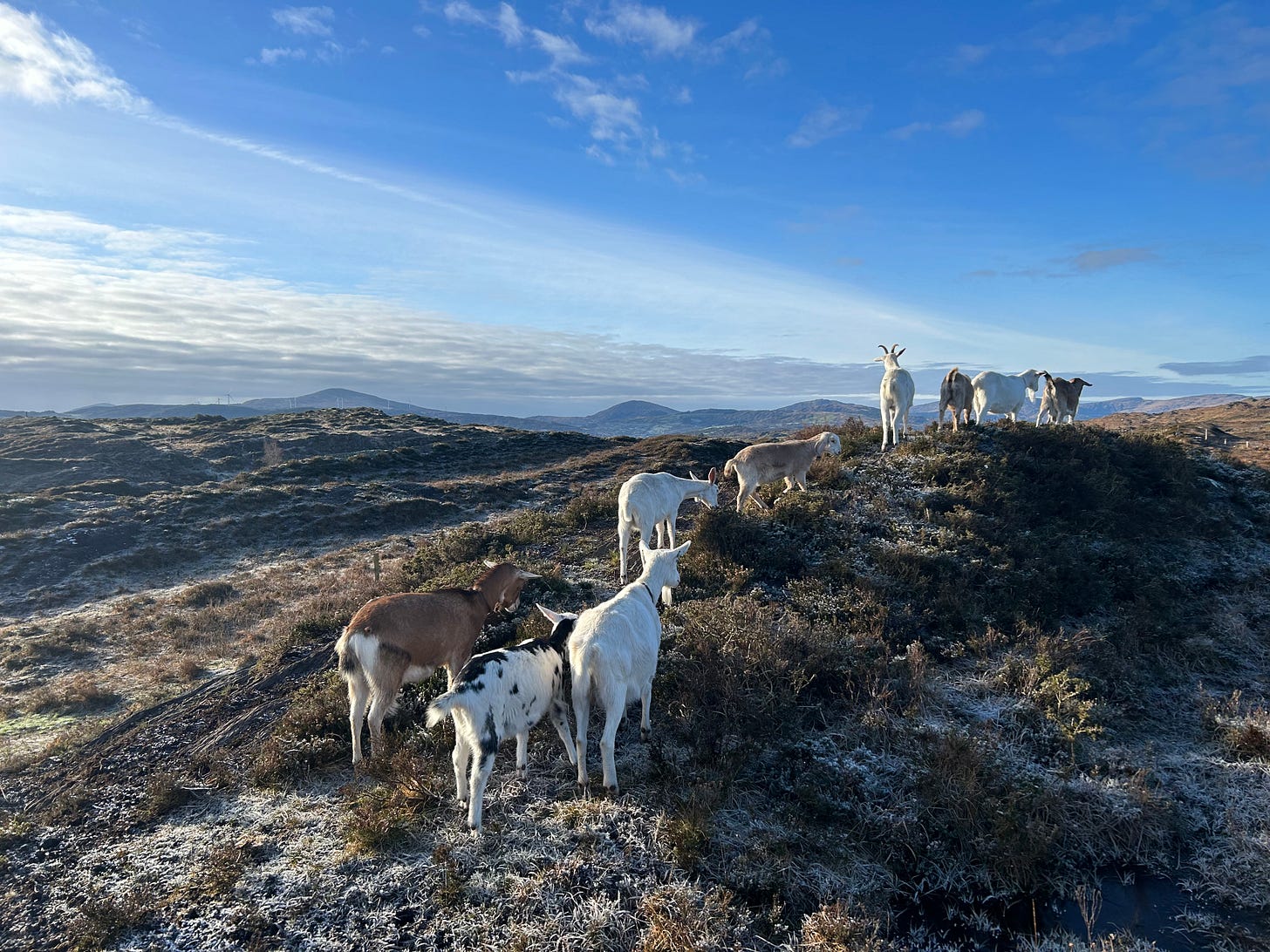
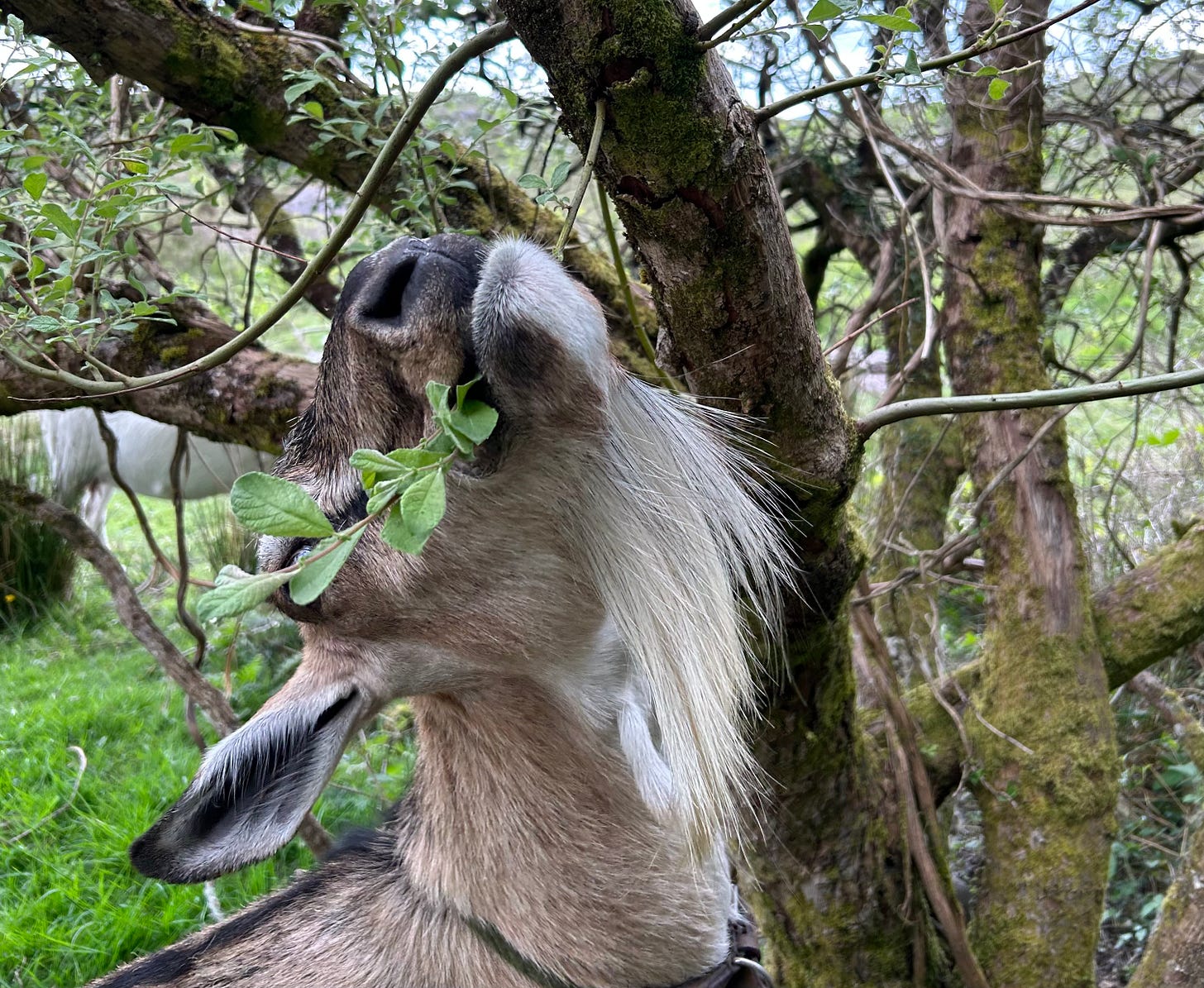
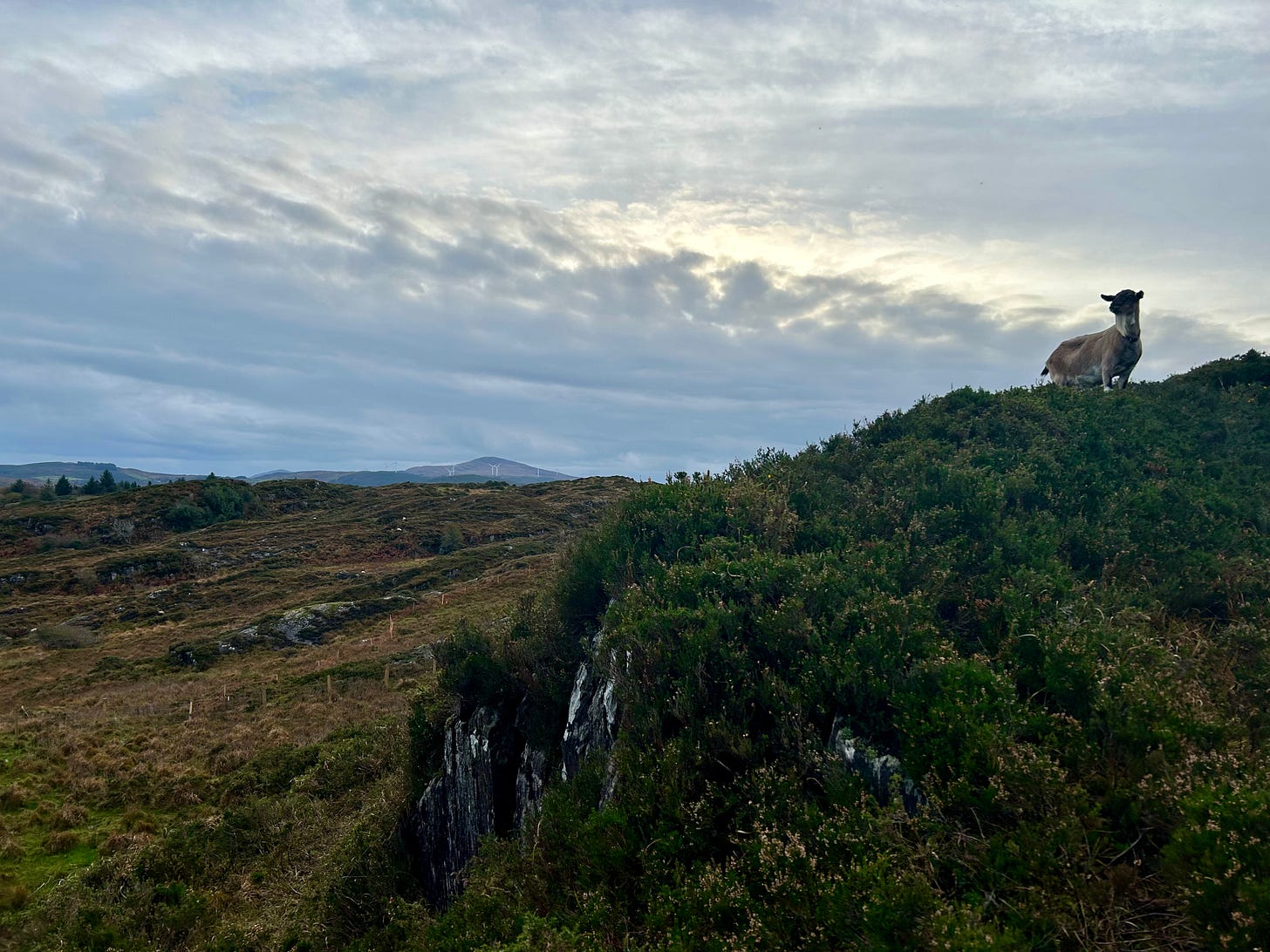
This is so challenging to me, in the best sort of way. I've grown up in a world and culture that has itself been mollycoddled, and taught me and so many to believe that in control and modernity we've found the best way of doing things. Yet in truth, what we've done is divorce ourselves from the land, and history, and all the wisdom that came before us. It's amazing to me to read of animals who have in their very bones what it takes not only to survive, but to thrive, and meanwhile watch a society of humans struggle to even answer the question, "What might it look like to live well?"
Carly, thank you for the reminder that there is more in our instincts than we give credit to.
I never knew they eat lichens off rocks, or the soil to get their minerals... such amazing creatures, thank you for sharing. 💕